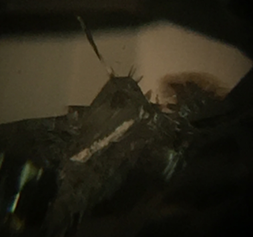It was and occasionally is the practice of some diamond polishers to dig facets to remove inclusions, naturals or cavities. Doing so allows the polisher to remove the problem/s but in the process another problem is created. What am I talking about? In short, compromised light return. The correct course of action to eliminate inclusions, naturals or cavities would be to re-profile (brute) the girdle of the diamond to allow for the problem/s to be eliminated and to create a diamond of maximum light return. Often this course of action is avoided to maintain a specific weight threshold of say 0.50ct 1ct, 2ct. But there are many diamonds particularly in the re-cycled market that have enough weight for rectification. Fixing a diamond with dug out facets normally result in substantial weight loss. When taking trade-ins, jewelers should be aware of the weight loss factor when pricing such diamonds.
When diamonds have painted facets, the weight loss is minimal and such diamonds can easily be fixed. The only caveat is to watch the weight threshold. A diamond that weighs exactly one carat will lose somewhere between 1.5-2% to be re-polished, causing it to fall in a lower price category. Something to watch out for are diamonds that have combinations of dug-out and painted facets. The image below left shows a diamond in the face-up view that looks symmetrically perfect, however the same model when viewed from the side as per the image on the right, shows a totally different reality and embodies a plethora of dug-out and painted facets.


A diamond set in a bezel setting could potentially have these problems which will only be revealed when the diamond is removed from its setting.
Old Europeans, chipped and damaged diamonds
Trading diamonds like poorly cut Old Europeans, which often have chipped girdles pose a significant problem. Some jewelers prefer to retain the Old European look and have the damages removed by minor polishing. That can often be done while still maintaining the authenticity of the cut. Whenever the chips are of such a nature that the diamond has to be re-cut, it then becomes logical to re-cut the diamond into a modern cut. It all boils down to marketability and price point.
Determining the weight loss of a diamond that needs to be re-cut could be complex in the cases where the diamonds have a combination of the following:
- Large culet
- Very flat pavilion or crown
- Very steep pavilion or crown
- Very small table
- Very large table.
- Chips and cavities in the girdle
Diamonds with these challenges are best handled when treated as rough by using concave mapping to determine the depth of chips and cavities. This allows for pretty accurate weight retention projections.
Whenever there are cavities, they are most often accompanied by feathers underneath them. There is an old Dutch saying that succinctly portrays the problem with the question: ‘Onder een gat ligt wat?’ Which translated means ‘under a hole lies what?’ The highly magnified image of a cavity below shows two of its ‘bedfellows’ i.e. feathers extending from the cavity.

Restoring diamonds can be challenging, yet astute jewelers can make additional margins by factoring in the risks mentioned in this article. As Baby Boomers and their heirs liquidate their jewelry assets, the phenomenon of recycled diamonds is a reality that is going to be with us for some years to come. Jewelers need to be educated to capitalize on these opportunities.
Given the challenging times we are living in, new opportunities need to be pursued for our industry to survive and even thrive. The possibilities are out there and the old maxim ‘one man’s trash is another man’s treasure’ still applies.


 RapNet Blog
RapNet Blog






![Diamonds 6[1][1]](/media/2120/diamonds-6-1-1.png)